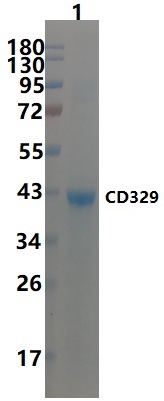Product Name :
CD329 Recombinant Protein Swiss-Prot :
Q9Y336 Host :
E.coli Tag :
Amino acid Sequence :
SELDPKGQHVCVASSPSAELQCCAGWRQKDQECTIPICEGPDACQKDEVCVKPGLCRCKP GFFGAHCSSRCPGQYWGPDCRESCPCHPHGQCEPATGACQCQADRWGARCEFPCACGPHG RCDPATGVCHCEPGWWSSTCRRPCQCNTAAARCEQATGACVCKPGWWGRRCSFRCNCHGS PCEQDSGRCACRPGWWGPECQQQCECVRGRCSAASGECTCPPGFRGARCELPCPAGSHGV QCAHSCGRCKHNEPCSPDTGSCESCEPGWNGTQCQQPCLPGTFGESCEQQCPHCRHGEAC EPDTGHCQRCDPGWLGPRCEDPCPTGTFGEDCGSTCPTCVQGSCDTVTGDCVCSAGYWGP SCNASCPAGFHGNNCSVPCECPEGLCHPVSGSCQPGSGSRDT Restriction sites :
NdeI-XhoI Background :
Two families of mammalian lectin-like adhesion molecules bind glycoconjugate ligands in a sialic acid-dependent manner: the selectins and the sialoadhesins. The sialic acid-binding immunoglobulin superfamily lectins, designated siglecs or sialoadhesins, are immunoglobulin superfamily members recognizing sialylated ligands. The common sialic acids of mammalian cells are N-acetylneuraminic acid (Neu5Ac) and N-glycolylneuraminic acid (Neu5Gc). Siglec-1 mediates local cell-cell interactions in lymphoid tissues and can be detected at contact points of macrophages with other macrophages, sinus-lining cells and reticulum cells. Siglec-7, highly expressed in monocytes and resident blood cells but not in parenchymatous cells, mediates inhibition of natural killer cell cytotoxicity. Siglec-9 is closely homologous to Siglec-7. It is highly expressed in peripheral blood leukocytes (not eosinophils), liver, bone marrow, placenta and spleen. Siglec-8, a type I membrane protein, is selectively expressed on human eosinophils, basophils and mast cells, where it regulates their function and survival. Soluble :
PBS, 4M Urea, PH7.4 Purification&Purity :
Transferred into competent cells and the supernatant was purified by NI column affinity chromatography and the purity is > 85% (by SDS-PAGE). Storage&Stability :
Store at 4°C short term. Aliquot and store at -20°C long term. Avoid freeze-thaw cycles. Expression vector :
pet-22b(+) BiowMW :
~42kDa Note :
For research use only, not for use in diagnostic procedure. concentration :
CD329 Recombinant Protein Swiss-Prot :
Q9Y336 Host :
E.coli Tag :
Amino acid Sequence :
SELDPKGQHVCVASSPSAELQCCAGWRQKDQECTIPICEGPDACQKDEVCVKPGLCRCKP GFFGAHCSSRCPGQYWGPDCRESCPCHPHGQCEPATGACQCQADRWGARCEFPCACGPHG RCDPATGVCHCEPGWWSSTCRRPCQCNTAAARCEQATGACVCKPGWWGRRCSFRCNCHGS PCEQDSGRCACRPGWWGPECQQQCECVRGRCSAASGECTCPPGFRGARCELPCPAGSHGV QCAHSCGRCKHNEPCSPDTGSCESCEPGWNGTQCQQPCLPGTFGESCEQQCPHCRHGEAC EPDTGHCQRCDPGWLGPRCEDPCPTGTFGEDCGSTCPTCVQGSCDTVTGDCVCSAGYWGP SCNASCPAGFHGNNCSVPCECPEGLCHPVSGSCQPGSGSRDT Restriction sites :
NdeI-XhoI Background :
Two families of mammalian lectin-like adhesion molecules bind glycoconjugate ligands in a sialic acid-dependent manner: the selectins and the sialoadhesins. The sialic acid-binding immunoglobulin superfamily lectins, designated siglecs or sialoadhesins, are immunoglobulin superfamily members recognizing sialylated ligands. The common sialic acids of mammalian cells are N-acetylneuraminic acid (Neu5Ac) and N-glycolylneuraminic acid (Neu5Gc). Siglec-1 mediates local cell-cell interactions in lymphoid tissues and can be detected at contact points of macrophages with other macrophages, sinus-lining cells and reticulum cells. Siglec-7, highly expressed in monocytes and resident blood cells but not in parenchymatous cells, mediates inhibition of natural killer cell cytotoxicity. Siglec-9 is closely homologous to Siglec-7. It is highly expressed in peripheral blood leukocytes (not eosinophils), liver, bone marrow, placenta and spleen. Siglec-8, a type I membrane protein, is selectively expressed on human eosinophils, basophils and mast cells, where it regulates their function and survival. Soluble :
PBS, 4M Urea, PH7.4 Purification&Purity :
Transferred into competent cells and the supernatant was purified by NI column affinity chromatography and the purity is > 85% (by SDS-PAGE). Storage&Stability :
Store at 4°C short term. Aliquot and store at -20°C long term. Avoid freeze-thaw cycles. Expression vector :
pet-22b(+) BiowMW :
~42kDa Note :
For research use only, not for use in diagnostic procedure. concentration :
Blocking peptide available as NCP0332P

 CD329 Recombinant Protein
CD329 Recombinant Protein 
 Datasheet
Datasheet COA
COA MSDS
MSDS SHIP
SHIP